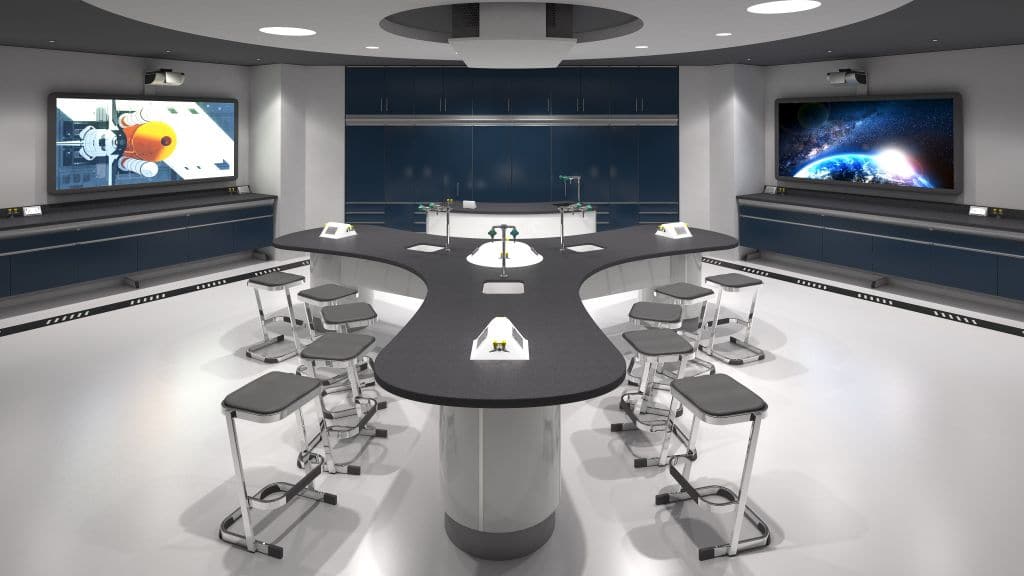By Mike Serridge and Kate Willoughby
Demand for STEM skills is strong across all economies and is set to grow in the coming years.
Despite this, the issue of falling numbers in the uptake of higher level science and technology-based education has been the subject of many debates, studies, and reports for several decades. There remains an ongoing concern and increased recognition of the need to reverse this trend.
Economies need well-trained scientists, technologist, engineers, mathematicians and teachers. To that end, pedagogy is changing with emphasis being placed on collaborative group work, research, project and context based integration between the related subjects.
This, in turn, creates a need for flexible learning spaces that not only facilitate the range of activities this entails but also attract students to subjects that might not otherwise seem appealing.
Studying science and mathematics unlocks a range of employment opportunities for young people. Success in promoting STEM education depends on high-quality, well-trained, motivated subject specialist teachers who are provided with the tools and environments with which to attract the students and to deliver effectively.
Students are more likely to engage in STEM subjects if they can see a tangible and relevant objective. Any new learning space needs to ensure that research, study, design, experimentation, testing and realisation can be readily accommodated, as well as having the widest possible student appeal.
STEM in schools suffers from image and perception issues that present challenges for educationalists who are trying to broaden the appeal of science and technology-based subjects to a wider cross section of the school population.
Students of the “online age” are not motivated or stimulated by dark, old fashioned, uninspiring school laboratory and workshop designs that have remained unchanged for decades.
Educators, subject advisors, school interior designers and specialist furniture suppliers are having to work much harder and become much more innovative to change these perceptions, help schools compete with what are regarded by some as the more contemporary subjects, and remove the gender bias associated with STEM based learning.
Effective interior design combined with high-quality contemporary furniture systems that facilitate and promote pupil-centered learning can help change attitudes towards science so that students are more receptive to the truly exciting possibilities that the subject offers.
Traditional regimented wooden bench rows with dark worktops are not only uninspiring, they are restrictive of interactive group work, they create areas within the classroom that are not easily accessed by teachers due to narrow gangways, they result in “back row” syndrome, and they are considered by many to be the least safest way to organise students carrying out practical work.
Replacing these very old designs with new, brighter colored, lower specification versions of the same thing might improve the image of STEM temporarily, but it does little to address the need for greater flexibility within the classroom.
It is too often the case that school laboratories and tech facilities look uncoordinated and lacking in any design quality.
Far from being inspirational and creating appeal amongst students, a mismatch of loose tables, old-fashioned fitted benches, and fume cupboards sourced at different times lacking any synergy in shape, color and form has completely the opposite effect.
Such environments look untidy, unprofessional, and out of touch with the way in which other subjects and, indeed, science and technology is evolving.
New more contemporary designs that utilize modern high specification materials in a less formal, more interesting and much more flexible way can provide the teachers with the sort of environment needed for modern pedagogy.
Such designs need not be restrictive of more formal, whole class address/demonstration as and when needed, from any one of a number of equally well-suited locations in the room rather than from a single fixed teaching position.
Crucially, the contemporary, flexible, application based innovative room layouts can change the image of STEM and help reverse the downward trend in student uptake.
There is value in involving the students in the design of new and or refurbished classrooms and in the selection of the furniture system, which is a key element in the efficacy of the environment. This involvement gives the students ownership of their own learning space and promotes the engagement that this engenders.
For most schools, the creation of a new STEM facility or refurbishment of a laboratory is a 25-year investment that will have to serve several generations of students and a number of different teachers during that time.
New age designs are highly space-efficient. They also provide generous worktop space per student and excellent circulation space, which encourages teachers to move around and engage rather than operating exclusively from the behind the same single fixed position bench all the time. This makes it possible to use the room in different ways and can help future-proof the new facility.
Never compromise quality or choice of application specific materials for things like worktops. Although budgets are always tight, selection should be made on the basis of best lifecycle value rather than lowest first cost, which is always a false economy.
Mike Serridge is managing director and Kate Willoughby is sales & marketing manager for S+B, www.splusbusa.com.














